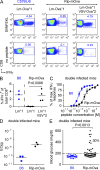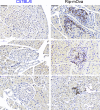Autoreactive T cells bypass negative selection and respond to self-antigen stimulation during infection
- PMID: 22987800
- PMCID: PMC3457731
- DOI: 10.1084/jem.20120905
Autoreactive T cells bypass negative selection and respond to self-antigen stimulation during infection
Abstract
Central and peripheral tolerance prevent autoimmunity by deleting the most aggressive CD8(+) T cells but they spare cells that react weakly to tissue-restricted antigen (TRA). To reveal the functional characteristics of these spared cells, we generated a transgenic mouse expressing the TCR of a TRA-specific T cell that had escaped negative selection. Interestingly, the isolated TCR matches the affinity/avidity threshold for negatively selecting T cells, and when developing transgenic cells are exposed to their TRA in the thymus, only a fraction of them are eliminated but significant numbers enter the periphery. In contrast to high avidity cells, low avidity T cells persist in the antigen-positive periphery with no signs of anergy, unresponsiveness, or prior activation. Upon activation during an infection they cause autoimmunity and form memory cells. Unexpectedly, peptide ligands that are weaker in stimulating the transgenic T cells than the thymic threshold ligand also induce profound activation in the periphery. Thus, the peripheral T cell activation threshold during an infection is below that of negative selection for TRA. These results demonstrate the existence of a level of self-reactivity to TRA to which the thymus confers no protection and illustrate that organ damage can occur without genetic predisposition to autoimmunity.
Figures







References
-
- Belz G.T., Behrens G.M., Smith C.M., Miller J.F., Jones C., Lejon K., Fathman C.G., Mueller S.N., Shortman K., Carbone F.R., Heath W.R. 2002. The CD8α+ dendritic cell is responsible for inducing peripheral self-tolerance to tissue-associated antigens. J. Exp. Med. 196:1099–1104 10.1084/jem.20020861 - DOI - PMC - PubMed
Publication types
MeSH terms
Substances
Grants and funding
LinkOut - more resources
Full Text Sources
Other Literature Sources
Molecular Biology Databases
Research Materials

